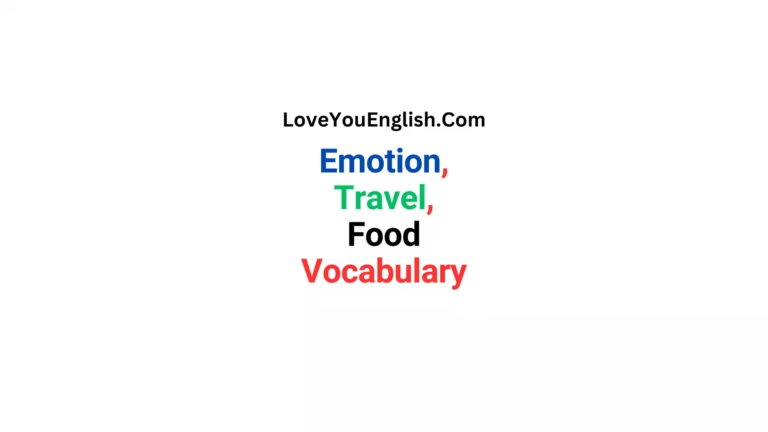English for Medical Workers: Key Vocabulary for Healthcare
“Sorry, I didn’t quite catch that—do you mean ‘medication’ or ‘mediation’?”
If you’ve ever had a moment like that in a hospital or clinic setting, you’re not alone.
English in healthcare isn’t just about grammar—it’s about getting the right word at the right moment. One small misunderstanding can make a big difference in a patient’s care.
Whether you’re a nurse in training, a doctor working internationally, or a caregiver helping out in an English-speaking environment, clear communication can save lives.
That’s why medical workers need more than just “good” English—they need the right vocabulary.
In this post, I’ll walk you through the essential English terms every healthcare professional should know.
I’ll go beyond flashcards—this is practical, real-world English from someone who’s spent over a decade teaching it to doctors, nurses, and support staff.
Ready?
Let’s dive in.
Why Medical English Is Different
Before we get into the words, let’s talk about why medical English is so important—and so tricky.
In my early years of teaching English at a nursing college, one of my students (a brilliant young nurse from Vietnam) once told a patient that their “condition was stable like a table.” Creative, yes. But the patient looked horrified. Why? They didn’t understand what she meant.
Here’s the thing: medical English is full of technical terms, polite requests, and sensitive language. You’re not just giving information—you’re building trust, showing empathy, and making people feel safe.
So what do you really need to know?
1. Basic Medical Vocabulary: The Building Blocks
Let’s start with the most common and essential terms. These are words you’ll hear every day in hospitals, clinics, and even at the pharmacy.
Common Symptoms and Conditions
-
Fever – a higher-than-normal body temperature.
-
Cough – a sudden, often repetitive, reflex that clears the throat.
-
Pain – discomfort (can be sharp, dull, throbbing, etc.).
-
Swelling – an area of the body that is larger than normal due to fluid.
-
Nausea – the feeling that you’re going to vomit.
-
Diarrhea – frequent loose or liquid bowel movements.
-
Infection – the invasion of harmful microorganisms in the body.
-
Fracture – a broken bone.
-
Hypertension – high blood pressure.
-
Diabetes – a chronic condition affecting blood sugar regulation.

Body Parts You’ll Talk About Often
-
Chest
-
Abdomen (stomach area)
-
Back
-
Joints (like elbows, knees)
-
Limbs (arms and legs)
-
Throat
-
Lungs
-
Heart
-
Kidneys
-
Liver
I often create flashcards or diagrams with my students for these—it helps connect the English word to the real location or function.
2. Talking to Patients: Useful Phrases for Clarity and Comfort
Medical staff don’t just use technical words—they ask questions, give instructions, and explain treatment plans. And often, they need to do it in simple, reassuring ways.
Here are some of my favorite patient-friendly phrases that you can start using right away:
Checking Symptoms
-
“Where exactly does it hurt?”
-
“Have you felt this way before?”
-
“When did it start?”
Giving Instructions
-
“Take this pill twice a day—once in the morning, and once at night.”
-
“Don’t eat or drink anything after midnight.”
Reassuring Patients
When I was training nursing students in India, we used to role-play these phrases in class—and honestly, it made a huge difference in their confidence on the job.
3. Emergency Language: Communicate Quickly and Clearly
In emergencies, every second counts. You can’t afford confusion. So here’s some vital vocabulary to keep in mind:
Urgent Conditions
-
Heart attack – blockage of blood flow to the heart muscle.
-
Seizure – sudden, uncontrolled electrical activity in the brain.
-
Anaphylaxis – a severe, life-threatening allergic reaction.
-
Unconscious – not awake or aware.
Useful Emergency Phrases
-
“Call for help immediately.”
-
“The patient is unresponsive.”
-
“We need to check their airway, breathing, and circulation.”
-
“Start CPR now.”
-
“Administer the EpiPen.”

4. Understanding Medical Tests and Procedures
Doctors and nurses often need to explain tests or procedures to patients. Here are some key terms and how to simplify them:
| Technical Term | Simple Explanation |
|---|---|
| MRI | A scan that takes detailed pictures inside your body. |
| X-ray | A quick image to look at your bones or chest. |
| Blood test | Taking a small amount of blood to check your health. |
| Biopsy | Removing a small piece of tissue to look for disease. |
| IV (intravenous) | Medicine or fluids given directly into a vein. |
| Surgery | A medical operation. |
You might say: “You’ll need a blood test to check for infection.” Or, “We’ll do an MRI to get a closer look at the area.”
Pro Tip: Always pause to check understanding. Ask, “Do you have any questions about that?”
5. Medical Abbreviations You Should Know
Hospitals love abbreviations—but for English learners, they can feel like a secret code. Here are some common ones:
-
BP – Blood Pressure
-
HR – Heart Rate
-
IV – Intravenous
-
OT – Operating Theatre / Occupational Therapy
-
ER / ED – Emergency Room / Emergency Department
-
Rx – Prescription
-
Dx – Diagnosis
-
Tx – Treatment
-
Hx – History
-
Fx – Fracture

6. Cultural and Language Sensitivity: The Heart of Medical Communication
Here’s a lesson that’s stuck with me for years.
One of my students, a nurse from the Philippines, once asked a patient in the UK, “Are you going to pass stool today?” The patient looked deeply uncomfortable. Why? Not because the question was wrong—but because it was too direct.
In some cultures, health talk is very open. In others, it’s more private. As a medical worker using English, you need to be aware of tone, word choice, and facial expressions.
What You Can Do:
-
Use indirect language for sensitive topics:
→ “Have you had a bowel movement today?” instead of “Did you poop?” -
Use open body language: eye contact, gentle voice.
-
Respect boundaries: some patients may not want to talk about certain issues.
Trust grows from how you speak, not just what you say.
7. Resources to Keep Learning (Because There’s Always More)
English in the medical field is always evolving. New diseases, new treatments, new tools—language grows with it. Here are some trusted places to keep learning:
-
MedlinePlus (by the U.S. National Library of Medicine) – medlineplus.gov
Great for simple, accurate medical definitions. -
English Med (free YouTube channel) – Lessons designed for medical professionals learning English.
-
British Council’s “English for the Workplace” – Offers specialized lessons for healthcare communication.
-
Apps like Quizlet – Search for “Medical English” flashcard sets.
Conclusion
If you’ve made it this far—thank you! That shows you’re serious about improving not just your English, but your ability to care for others.
Medical English isn’t about sounding fancy—it’s about being clear, calm, and kind under pressure.
As someone who’s trained hundreds of healthcare students, I can tell you this: the best communicators are not the ones with the biggest vocabulary.
They’re the ones who listen well, speak simply, and care deeply.
So, start small. Practice a few phrases each day. Use role-plays. Ask questions. And most importantly, don’t be afraid to make mistakes—they’re part of the learning process.
Because in healthcare, every word matters. And you’ve got what it takes to use the right ones.
Now it’s your turn: What medical English word or phrase do you find most useful?
Or most confusing? Leave a comment or send me a message—I’d love to help!







